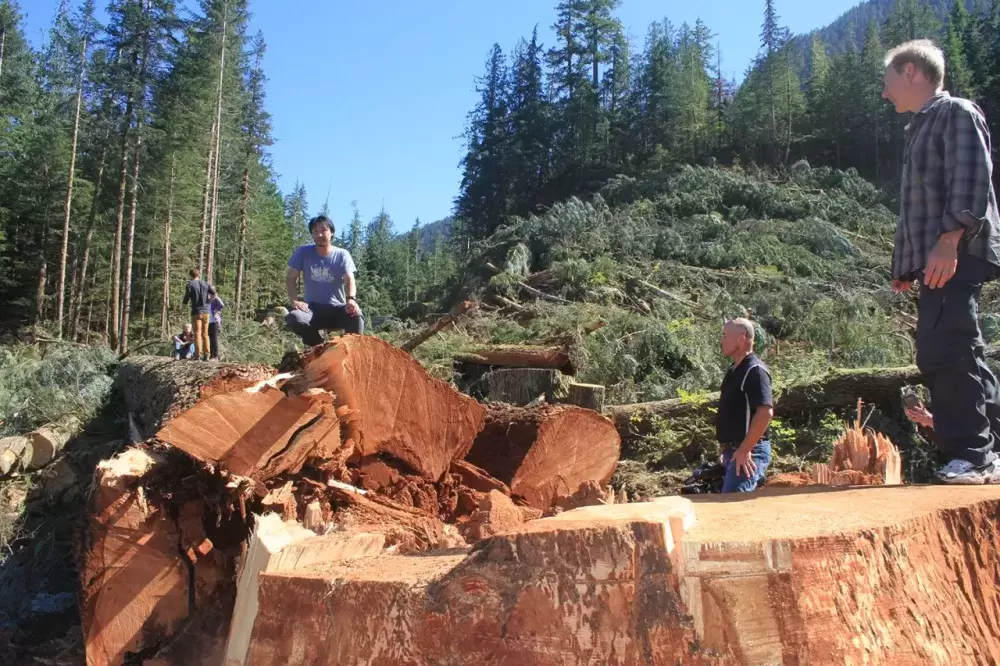Citing the ongoing threat to spiritual places of cultural significance to Nuu-chah-nulth people, the NTC is calling on the provincial government to slow down old growth logging on the west side of Vancouver Island.
This message came from the Nuu-chah-nulth Tribal Council on Monday, Nov. 5, in a statement stressing the traditional importance of red and yellow cedar trees that existed before European settlement. The NTC states that these trees are still relied upon for its people to continue their traditions by harvesting for longhouses, canoes, totem poles, welcoming figures, clothing and regalia.
“Old growth forests are invaluable ecosystems that can never be reproduced,” stated NTC Vice-president Andy Callicum in the media release. “The forests play an important role in protecting wildlife throughout the winter, and for providing Nuu-chah-nulth peoples the medicines and roots contained within them.”
This year forests across British Columbia are facing intensified threats after the province saw the most extensive wildfire season on record. Over 1.35 million hectares of forest burned in 2018, a wave that hit Vancouver Island in August with a series of wildfires throughout Nuu-chah-nulth territory. This included dozens of fires in the north sparked by an Aug. 11 lightning storm, bringing long-term slope instability that continues for the Village of Zeballos.
“The forests are vanishing with the permission of the province, and have been further endangered by the rampant B.C. forest fires,” stated the NTC. “Joint management through Indigenous laws, B.C. laws and other workable mechanisms is critical in curtailing further damage.”
Current harvesting in the Nahmint Valley, which is located southwest of Port Alberni, shows a failure to consult with local First Nations, according to the Tseshaht. The First Nation said that between November 2017 and March 2018 five harvesting licences were auctioned off by BC Timber Sales from Tseshaht territory without their consent.
This area includes trees with some of the largest dimensions in Canada, including a Douglas Fir that measured 10 feet in diameter before it was cut down in May. That Douglas Fir ranked among the top 10 largest of its species in the country, according to the BC Big Tree Registry, a public record managed by the University of British Columbia. The Nahmint Valley also contains a 14-foot-wide Western Red Cedar and a 12-wide Douglas Fir, boasting dimensions that could age the fir tree to be over 1,000 years old. The Nahmint Valley’s current old-growth logging activity was first publicized by the Ancient Forest Alliance last spring.
“We have expressed the need for a cedar management strategy in Tseshaht territory as well as the need for a shared decision making framework,” said the First Nation’s Chief Councillor Cynthia Dick in an email in late May.
In May Doug Donaldson, B.C.’s minister of Forests, Lands, Natural Resource Operations and Rural Development, stated that his NDP government has set aside $16 million over three years to update its land use plan.
“The new government is committed to modernizing the land use planning process and protecting old growth forests is a vital component of that,” he said. “The first step is collaborating with Indigenous Peoples.”
In June the ministry of told Ha-Shilth-Sa that negotiations on a reconciliation agreement with the Tseshaht were underway, but any progress on these talks have yet to be publicized.
“Our government is deeply committed to true and lasting reconciliation with First Nations and Indigenous Peoples in B.C.,” stated the ministry. “In May, our public service was given 10 draft principles as a resource to help guide the work required to fulfill government’s commitment to implement the United Nations Declaration on the Rights of Indigenous Peoples and respond to the Truth and Reconciliation Commission’s Calls to Action and recent direction from the courts.”
But as trucks loaded with old-growth logs continue to pass through Port Alberni, NTC President Judith Sayers believes that the ongoing harvesting in Nuu-chah-nulth territories shows that the province is failing to uphold the United Nations declaration.
“At least five articles within UNDRIP reference our right to make decisions in matters that affect our rights,” she said in the NTC media release. “The right to our medicines, the right to strengthen our spiritual relationship with our territories, the right to the protection of the environment and to give consent on any development that affects our lands and resources.”







